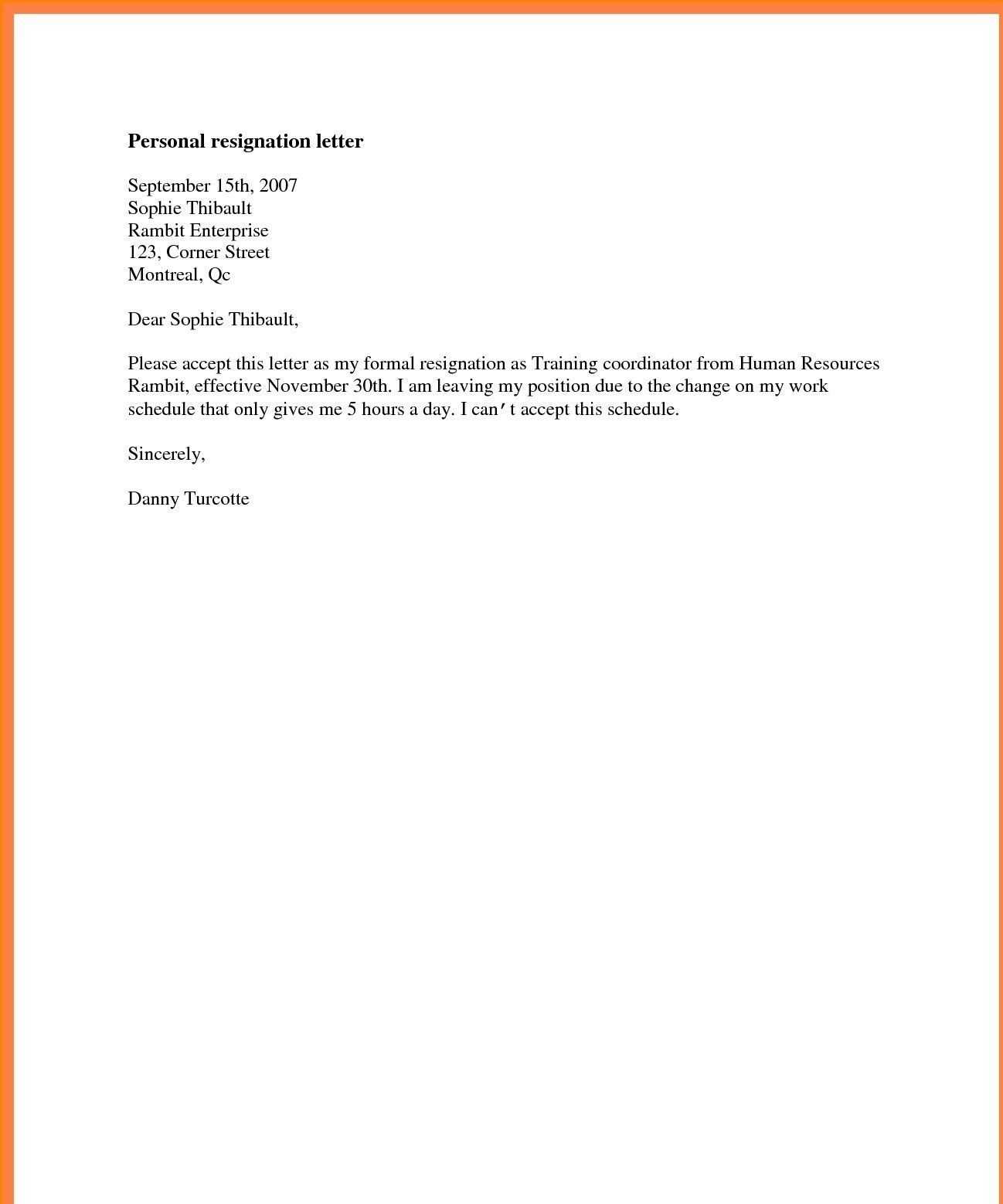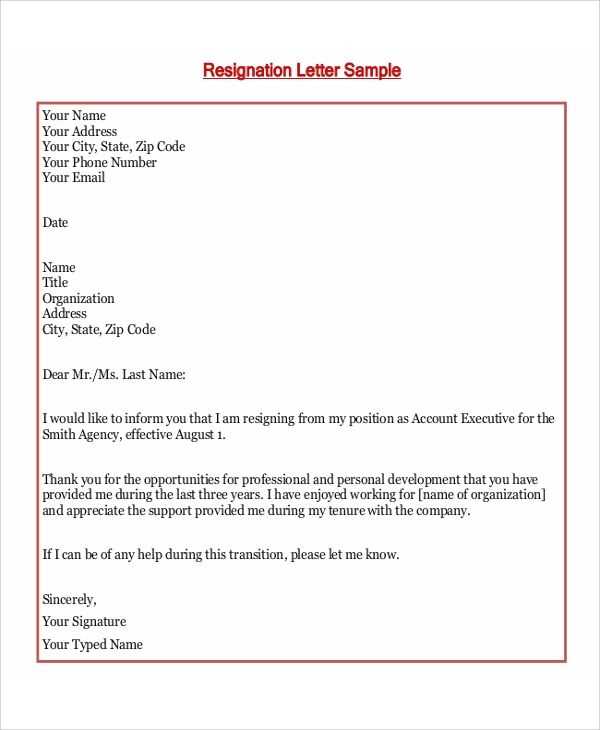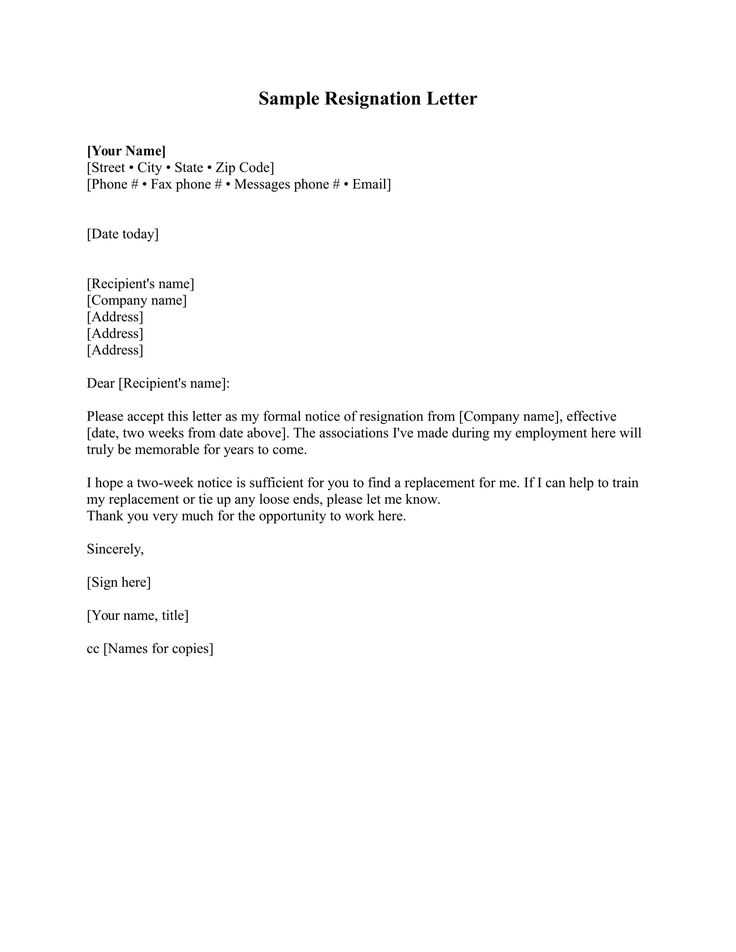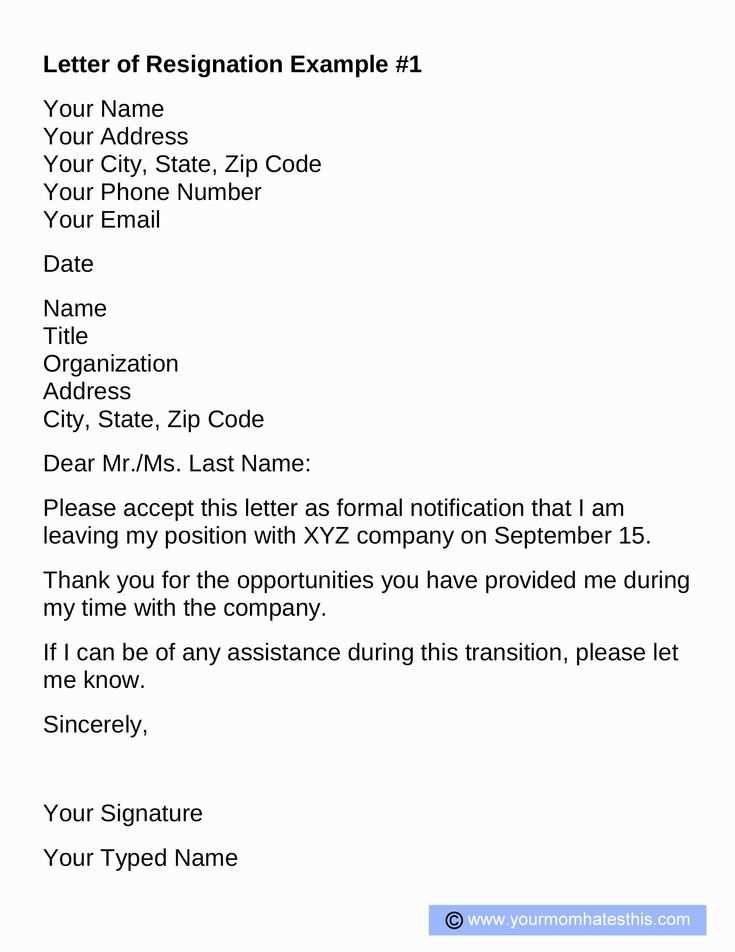Basic Letter of Resignation Template for Professionals

Leaving a position can be an emotional experience, but it is important to handle the departure professionally. A well-written communication ensures you part on good terms with your employer and colleagues. This document serves as an official way to inform your workplace of your decision to move on while maintaining respect and gratitude for the time spent there.
It’s crucial to structure your message in a clear, concise, and polite manner. A positive tone will help leave a lasting good impression and keep relationships intact. There are certain elements to include, making sure the content is appropriate and respectful, yet straightforward about your intentions to transition out of the company.
In this guide, we will provide helpful pointers for composing a formal exit notice. This advice will assist you in drafting a message that fits various situations, ensuring professionalism throughout the process. The goal is to leave behind a sense of appreciation and mutual respect between you and the organization.
Understanding a Farewell Message
When leaving a company, it’s essential to communicate your departure in a formal and respectful manner. A properly constructed communication serves as a professional exit and helps maintain a positive relationship with your employer. Knowing how to organize your thoughts and present your departure can make the transition smoother for both parties.
There are key aspects to consider when crafting this document. These elements include clarity, respect, and acknowledgment of the opportunities provided. The tone should be professional yet appreciative, ensuring that your message conveys both gratitude and professionalism. Below, we will break down the main components that should be included in such a document.
Important Elements to Include
| Component | Description |
|---|---|
| Opening Statement | Clearly state your intention to leave and mention the position and company name. |
| Reason for Departure | Optionally provide a brief reason for your decision, though it’s not always necessary. |
| Express Gratitude | Thank the company for the opportunity and highlight any positive experiences. |
| Final Working Day | Specify your last day to ensure a smooth transition. |
| Closing | End with a positive note, wishing the company continued success. |
Tone and Professionalism

While the content is important, the tone of the message plays a critical role in how it will be perceived. A positive, professional approach ensures that the message remains respectful and cordial. The purpose of this communication is to leave on good terms, so focusing on polite language and a gracious attitude will help preserve your professional image.
Essential Parts of a Farewell Message
When preparing to announce your departure from a position, it’s important to structure the communication in a way that clearly conveys your decision while maintaining professionalism. A well-organized message ensures that all necessary details are addressed, leaving no room for ambiguity or misunderstanding. The key is to keep the content focused and relevant, highlighting the most important aspects of your departure.
Each part of the message serves a specific purpose. Whether you are expressing gratitude or specifying your final working day, every section of the message should be thoughtfully constructed to ensure clarity and respect. The following elements are critical to creating a complete and effective communication.
Key Components to Include
| Component | Description |
|---|---|
| Opening Statement | State your intention to leave the company in a straightforward manner. |
| Reason for Leaving | Include a brief explanation, if desired, but it is not mandatory. |
| Appreciation | Express thanks for the opportunities, experiences, and relationships developed. |
| Last Day of Work | Provide a clear end date to assist with transition planning. |
| Closing | End on a positive note, wishing the company success in the future. |
Keeping the Message Professional
While the message should be concise, the tone should always be professional. A respectful and positive attitude ensures that the departure is handled smoothly. Avoid any negativity or overly personal details, as the purpose is to leave behind a constructive and professional impression, which could be beneficial for future career connections.
How to Begin Your Departure Notice
The beginning of your communication is crucial as it sets the tone for the rest of the message. It’s important to start clearly and directly by stating your intention to leave. This ensures there is no confusion about your decision and immediately communicates the main purpose of your message. A direct approach helps maintain professionalism while still conveying respect.
Starting the message in a straightforward manner allows the employer to understand your position and move forward with any necessary steps for your transition. Whether you choose to make the announcement simply or add a bit more context, it should always be clear and concise.
Simple Opening Statement
A simple and direct opening is often the most effective. Begin by stating that you are leaving and provide the name of your role and company. There is no need for lengthy explanations at this point, as the purpose is to make your intentions known.
Consider Adding Context
If you feel it’s appropriate, you may want to briefly explain your decision to leave. This could be in the form of a few words about new opportunities or personal reasons. Keep it professional and avoid excessive details to maintain a positive tone.
Maintaining Professionalism During Your Departure

When informing your employer of your decision to leave, it’s essential to maintain a professional attitude throughout the process. Regardless of your reasons for leaving, ensuring that your message is respectful, clear, and tactful will help preserve your reputation and the relationships you’ve built during your time with the company. How you communicate your decision can have a lasting impact on your career and future opportunities.
To ensure your departure is handled professionally, consider the following guidelines:
Key Guidelines for Professionalism
- Be concise and clear about your intentions without unnecessary details.
- Express gratitude for the opportunity to work with the company.
- Maintain a positive tone and avoid any negative comments or criticisms.
- Offer assistance with the transition process, if possible, to show cooperation.
- Respect confidentiality agreements and company policies regarding departure procedures.
Avoiding Common Pitfalls
It’s important to avoid behaviors that can damage your professional image, such as:
- Giving minimal or vague notice without clear communication.
- Expressing frustration or dissatisfaction in your message.
- Leaving abruptly without completing necessary responsibilities or offering assistance for the transition.
By keeping your departure professional, you ensure that you leave on good terms and leave a positive impression that could benefit you in the future.
Frequent Mistakes to Avoid
When composing your departure notification, there are several common missteps that can negatively affect the message’s tone and impact. These errors can result in misunderstandings, hurt feelings, or even damage to your professional reputation. Being aware of these mistakes helps you craft a clear and respectful communication, ensuring a smooth and professional transition.
To ensure your departure message is well-received, avoid these common errors:
Common Pitfalls to Watch Out For
- Providing little or no notice, leaving the company unprepared for your exit.
- Using negative language or venting frustration about the job or colleagues.
- Being overly informal or too brief, which can be perceived as unprofessional.
- Failing to express gratitude for the opportunities provided during your employment.
- Over-sharing personal details that are irrelevant to the situation.
How to Avoid These Mistakes
By adhering to the following practices, you can avoid these common mistakes:
- Give ample notice to allow for proper planning and transition.
- Keep your message polite and positive, focusing on gratitude and professionalism.
- Maintain a formal tone, even if you have a good relationship with your employer.
- Focus on the facts and avoid emotional outbursts or unnecessary personal information.
By following these guidelines, you can ensure that your departure is both professional and respectful, leaving a positive impression behind.
When to Hand in Your Notice
Timing plays a crucial role in the departure process. Deciding when to submit your notice can significantly impact the transition and your relationship with your employer. It’s essential to strike a balance between giving enough time for planning and respecting the needs of the organization while ensuring that you follow the terms of your contract or company policies.
Consider the following factors when determining the best time to submit your notice:
- Review your employment contract to ensure you’re adhering to any required notice periods.
- Take into account the nature of your role and whether a longer transition period might be necessary for your responsibilities.
- Plan to submit your notice early enough to allow your employer to prepare for your departure.
- Ensure you have all personal and professional matters in order before making the announcement.
By choosing the right moment, you can leave on good terms and contribute to a smooth handover process for both you and your employer.
Sample Template for Your Notice

Crafting a clear and respectful message is important when informing your employer about your decision to leave. Below is a sample structure to guide you in writing a professional notice. It outlines the key elements you should include to ensure your communication is polite, concise, and effective.
Here’s an example structure you can follow:
[Your Name] [Your Address] [City, State, ZIP Code] [Email Address] [Phone Number] [Date] [Employer's Name] [Company Name] [Company Address] [City, State, ZIP Code] Dear [Employer's Name], I am writing to formally inform you of my decision to leave [Company Name] effective [last working day, typically two weeks from the date of the letter]. I have greatly appreciated the opportunity to work with such a supportive team, and I am thankful for the professional development I have gained during my time here. Please let me know how I can assist in making the transition process as smooth as possible. I remain committed to completing any pending tasks and ensuring a thorough handover of my responsibilities. Thank you once again for the opportunity. I wish you and the team continued success. Sincerely, [Your Name]
This format helps ensure that your message is professional and clearly communicates your intentions, making it easier for your employer to understand your decision and plan accordingly.